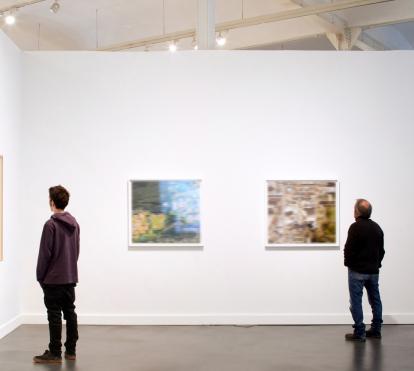
"Photography a matter of putting your brain, your eye and your heart in the same line of sight." Henri Cartier-Bresson (Chenteloup, France, 1908) left an indelible, highly personal mark on the world of photography. Blessed with a subtle, intelligent eye, he crafted keen portrayals of the major artistic, social and political movements of the 20th century. ”La Caixa” Foundation now presents in Spain the largest retrospective exhibition ever held on the French photographer's work. Featuring 350 items, some undisplayed until now, the show takes visitors on a voyage through Cariter-Bresson's life: remembrances of childhood (publicly exhibited for the first time); personal effects and papers (like shots of Cartier-Bresson as a prisoner of war in Stalag, Germany, circa 1940); drawings sketched by the photographer himself, pictures of the countries that most captured his attention (China, Mexico, India); celebrity portraits (Jean-Paul Sartre, Giacometti, Henri Matisse); original vintage prints, and more. The showing, produced by the Henri Cartier-Bresson Foundation and organised by ”La Caixa” Foundation and Magnum Photos, has already been shown at the National Library of France (Paris). After its display at CaixaForum, it will travel to Berlin, Rome and Edinburgh. The Henri Cartier-Bresson. Retrospective exhibit, curated by Robert Delpire, photography history expert and personal friend of Cartier-Bresson, can be visited at CaixaForum (Av. del Marquès de Comillas, 6-8), from 19 September, 2003 to 4 January, 2004.The objective of this retrospective exhibition is to show for the first time to the public the essential ideas and works of Henri Cartier-Bresson, based on the personal relationship and dialogue established between curator Robert Delpire and the photographer. Thus, the show also becomes a tribute to the artist. Among the 350 works exhibited there are some 250 photographs, 50 vintage prints, 28 original sketches by Cartier-Bresson and several previously undisplayed images, in addition to family and childhood photographs, personal belongings, book layouts and original publications. The exhibition takes visitors on a voyage through the artist's life, stopping at several points along the way:AmericaThe United States is among the preferred topics for photographers with an inclination toward spectacular subject matter. These images yield Cariter-Bresson's America, which the photographer recorded on his successive travels between 1946 and the late 1970's. Cartier-Bresson bypassed the large open spaces and gigantic proportions of the cities, opting for things closer at hand. Thus, he built his personal view of America based on its inhabitants. From elegant New Yorkers to African Americans in South Carolina ghettos, he pieced together an American chronicle through the surprised, critical or fascinated lens of a European photographer. Bali (Indonesia)After his 1949 trip to Indonesia, Cartier-Bresson turned out a reportage on Bali theatre, a blend of dance, song and pantomime. His photographs are a testimony to the actors' grace, refined wardrobe and ornamentation, precise movements and variety of expression. They also convey the spirituality emanating from this immensely popular art form. ChinaA veritable travel diary, the Cartier-Bresson's work during his 11-month stay in China is an invaluable historical testimonial. In July 1946, China was plunged into civil war between communist and nationalist forces. The photographer arrived in Peking in December, 1948 and stayed 12 days in the city before it fell to Mao's troops. Upon learning that the front was approaching the Yangtze River, he quickly made for Nankin, capital of Keomintag. He witnessed the departure of the nationalist troops and arrival of the people's army. In July 1949, he left for Hong Kong and concluded his trip. EuropeOver a thirty-year period, Cartier-Bresson travelled France, Italy, Spain, England, Ireland, Germany, and other nations. By bringing to light the differences and similarities among the countries, and showing their people, the photographer narrates the history of the European continent, revealing the constituent elements of their cultural, religious and social identities.IndiaCartier-Bresson spent prolonged periods in India. During his first trip in 1948, he had the opportunity to photograph Gandhi minutes before his death, and the public fervour of the ensuing funeral ceremonies. He conveyed the atmosphere, philosophy and inner life of a society through its ceremony and religion, which deeply imbued his work. The photos taken in later trips (1966 and 1980) are charged with an even greater degree of abstract expression, crystallised and condensed in his photographic outlook. His pictures are testimony to his fascination with Indian culture and philosophy. MexicoCartier-Bresson travelled twice to Mexico: 1934 and 1964. The photographs of landscapes, children, street life, prostitutes, etc. taken on the two expeditions are strikingly similar, as if time had stood still for thirty years. This is because the photographer portrayed on both visits a part of Mexico's eternalness, chief ingredient of its history and cultural identity. USSRCartier-Bresson made his first trip to the USSR in 1954. Accompanied by an interpreter, he became absorbed in the local population, their work, pastimes, and overall, details of daily life. Nineteen years later, he wished to return, as, in his own words, "nothing's more revealing than comparing a country with itself, capturing its differences, and attempting to discern the keys of its continuity." PortraitsThroughout his career, Cartier-Bresson took myriad portraits, often of anonymous citizens, but also celebrities. From Jean-Paul Sartre to Giacometti, Colette to Pierre Bonnard and Henri Matisse, through a certain look, furtive attitude or in the intimacy of a one-on-one conversation, the photographer was able to seize and offer subtle insights into a personage.SketchesCartier-Bresson, who studied in painter André Lhote's studio before becoming a photographer, never lost his passion for sketching and drawing. In the 1970's, Cartier-Bresson put an end to his world travels and almost exclusively devoted himself to sketching. In examining his work (black lead, ink, tempera), one gains deeper comprehension of his unceasing search for balanced composition, respect for geometry and insightful observation skills. More Information: Cartier-Bresson's choice Henri Cartier-Bresson. RetrospectiveFrom 19 September, 2003 to 4 January, 2004CaixaForumAv. Marquès de Comillas, 6-808038 BarcelonaTel.: 902 22 30 40Hours:Tuesday to Sunday, holidays, 10 am to 8 pmMondays closed, except holidaysFree admissionwww.fundacio.lacaixa.es